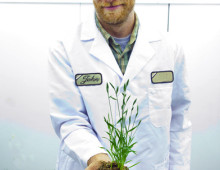A British- and U.S.-led international consortium says it has sequenced the first member of the wheat and barley group of grasses. The scientists, led by Britain’s John Innes Center, the U.S. Department of Energy’s Joint Genome Institute, the U.S. Department of Agriculture and Oregon State University, said the genome sequencing was of the wild grass…
Brachy project on USDA-ARS news site
A major stumbling block in using switchgrass or any perennial grass as a biofuel crop is the difficulty in breaking down its cell walls, an essential step in producing ethanol from cellulosic biomass. Brachypodium may hold the key to finding ways to produce plant cell walls that are easy to break down, Vogel said. Vogel…
Brachy genome project on Federal Times
Federal researchers have been hard at work trying to develop alternate sources of clean renewable energy, and yesterday they announced a major breakthrough in their efforts. Scientists from the Agriculture Department and the Energy Department’s Joint Genome Institute for the first time have sequenced the genes of a wild grass species. The research, which is…
Brachypodium genome project on Farm Futures
USDA scientists and their colleagues at the Department of Energy’s Joint Genome Institute say they have completed sequencing the genome of a kind of wild grass that will enable researchers to shed light on the genetics behind hardier varieties of wheat and improved varieties of biofuel crops. The grass, Brachypodium distachyon, can be used by…
Brachypodium genome project on UPI
The scientists, led by Britain’s John Innes Center, the U.S. Department of Energy’s Joint Genome Institute, the U.S. Department of Agriculture and Oregon State University, said the genome sequencing was of the wild grass Brachypodium distachyon. The researchers said three different groups of grasses, represented by corn, rice and wheat, provide most of the…
Brachypodium genome project on UC Newsroom
“The sequencing and analysis of the Brachypodium genome is an important advance toward securing sustainable supplies of food, feed and fuel from new generations of grass crops,” said DOE JGI collaborator John Vogel of the U.S. Department of Agriculture Agricultural Research Service (ARS). “Since Brachypodium has the traits required to serve as a functional model…
Brachypodium genome on ScienceDaily
Representative genomes for two of the three major subfamilies of grasses ⎯ those that include rice, maize, sorghum and sugar cane⎯ have already been sequenced. Now in the February 11 edition of the journal Nature, the International Brachypodium Initiative, a consortium which includes researchers from the DOE Joint Genome Institute (DOE JGI), presents the complete…
Brachy genome work on ScienceDaily
Representative genomes for two of the three major subfamilies of grasses ⎯ those that include rice, maize, sorghum and sugar cane⎯ have already been sequenced. Now in the February 11 edition of the journal Nature, the International Brachypodium Initiative, a consortium which includes researchers from the DOE Joint Genome Institute (DOE JGI), presents the complete sequence of…
Brachypodium distachyon genome work on ScienceDaily
Representative genomes for two of the three major subfamilies of grasses ⎯ those that include rice, maize, sorghum and sugar cane⎯ have already been sequenced. Now in the February 11 edition of the journal Nature, the International Brachypodium Initiative, a consortium which includes researchers from the DOE Joint Genome Institute (DOE JGI), presents the complete sequence of…
First Wild Grass Species and Model System for Energy Crops Sequenced
WALNUT CREEK, CA—As the U.S. Department of Energy (DOE) works toward developing sustainable sources of clean renewable energy, perennial grasses have emerged as major candidates for the commercial production of cellulosic biofuels from feedstocks. However, little is known about the specific biological traits of the grasses that might contribute to their usefulness for energy production,…
